
CHAPTER 1 19 Bits Mapped 21 The Pixel 23 Constructing Elements in Pursuit of Impossibility 25 1988, the Year of the Pixel 31 Pixel Creating Cultures 40 Preserving the Pixel, Releasing Style from Technology 45 The Contemporary Binary Bitmapped Surface 48 D raw by hand within the space of a digital image 78 Resolve to true or false with tons of information
CHAPTER 2 83 Every Grid is Material
CHAPTER 3 123 Using a Tree to Represent a Tree 127 Bonsai is an Action and an Element 128 Books About Bonsai are Like This Book 129 The Tree Behind the Tree 133 Designing Tools to Control or Release Natural Randomness 140 Random Salt Crystals 142 Who is the “User-Author”? 143 Using Software the Wrong Way 149 A Tree Yet Rendered is Three Hundred Text Files in a Folder 150 Sometimes a Tree Looks Nothing like a Tree 154 Everything is Bonsai when in Pursuit of Bonsai 156 Over Time, of Time 159 The Pot is a Diorama
BY
JULIE
KRESS 87 Every tool is Pre-Gridded 89 Every Grid is Aesthetic 94 Every Grid is Constructed 99 Every Grid is Imposed 102 Build and Break a Scaffold 105 Every grid wants to go on infinitely 107 Every grid has mass 112 Contain a Grid 115 Every grid does not need to be the same 118 Un-Standardized Fixtures
CHAPTER 4 165 A Room that Becomes a Diorama; A Diorama Afflicted with Room Envy 167 Almost but not Quite a Diorama: The Room, its Powers, and its Limits 172 Model your space with every regard for detail and no regard for accuracy 173 All Apertures Become Dioramas 184 The Room as a Diorama 188 Model from Memory 189 American Landscape as Diorama 196 Like (Performed) Magic 208 Can a Diorama be Separated from Its Content?
6
Contents 9 Acknowledgments 11 Introduction
AR+D
CHAPTER 5 217 Rendering the Almost Invisible 221 Straining to Become Invisible 226 Unrealistic Material 227 Massive, but Immaterial 238 Can a Diorama Become Invisible? 240 Everything but the Thing 242 What about the shape of the invisible element? 243 Essentially Animate
CHAPTER 6 249 Operating on the ViolenceAggression Axis
BY VIOLA AGO
251 In the Space of Animate Memory Sequences 254 Transformation Matrix 256 Relational Architecture: Between Violence and Aggression 258 Chop, D rop (does it Roll?) 259 Intentionally Corrupted Surface, the Resurgent Line 266 Surface Frictions 267 Lyricism and Empathy (Or Bad Responses to External Calls) 271 On Haptic Sways Between Fiction and the Real 282 Overcoming Systemic Cognition
CHAPTER 7 287 Anxious Vision:Real Time and the First-Person PerspectiveView
BY HANS TURSACK
289 Picture Windows 291 No Time Like Real Time 302 Tunnel Vision 305 Design Notes: Levels as Perceptual Arenas 310 Objects in a Networked Field: The Architectural Complex 312 Object-Buildings in a Complex 314 A Complex Without a Game 315 Linear Movement in a Complex 318 Play the Complex 321 The Creative Necessity of Gaming Discourse 322 Displacement of the Viewing Subject
CHAPTER 8 329 Transition Elements: Rendering by Drawing 332 The Case for Lines 342 Geometry of the Surface 349 Words and Reality 357 Optics of Material 365 Representation as an Open Loop 366 Represent, Disassociate, Operate, Re-associate with Something Else 370 Structure Discourse Around Exercises 375 Image Animation Index
7
AR+D
Pixel Creating Cultures
Let’s return to two terms mentioned earlier: “pixel-precision” and “pixel-subservience to gray tones.” Pixel-precision refers to the manual control of each pixel. We might use the term “by hand” to describe this craft. Such a label, though easily confused with the direct use of physical media, is accurate in the sense that the hand controls a mouse, which in turn can control an interface element that adjusts one or more pixels at a time and without delay. This is unlike the indirect execution of filters, procedures, or algorithms that take time or a sequence of steps to play out. The state of pixels are not generated, but controlled, directly. Pixel-precision leaves open the possibility that the individual or small clusters of pixels are perceptible in the final image at full size. Think of single pixel representing a star in the sky, a particle of mist, or a connected sequence of pixels representing a strand of hair. In these cases, the pixels retain their discrete and figural qualities; they don’t recede into each other. Yes, this phenomenon is dependent on the relatively low resolution (by today’s standards) of MacPaint images, but there’s something else at play.
Let’s now consider, “pixel subservience.” Using today’s image processing technology, one can easily open a digital photograph and convert it to a binary bitmap image. Most image editing software can do this using one of multiple algorithms. The “50% threshold” algorithm simply checks to see if the value of the input pixel was closer to black or white and outputs one of those two values accordingly. More complex algorithms would consider the grayscale value of an area of the input image and generate a pattern of black and white pixels to match that value. Each pixel would be subservient to the mission of articulating a gray value. That is, the perception of gray made possible by processing clusters of pixels together as a single value. The resulting image can be said to appear gray if one doesn’t zoom in too closely. But those processed pixels will likely lack a sensitivity to the content of the image. Lines and strong edges are especially difficult to sustain in a conversion into binary bitmap from a source image. Pixel-precision methods, on the other hand, allow (and require) the assertion of lines and hard edges.
Pixel-precision, when coupled with pixel-subservice, blurs the line between drawing and rendering in the sense that a pictorial scene with shadow and tone can be constructed (as in, rendered) but that scene is built up with a system of representation (like a drawing).
Crafting gradients with a mixture of pixel-precision and pixel-subservience is similar in concept to what can be achieved with hatching in a material
31 Ch A p T e R 1
AR+D
drawing. In a strict line drawing, there is no melting down or blurring of the line. There is only line, or lack of line just as in these images the pixels are either black or white. Dense clusters of repeating lines are perceived in terms of value. MacPaint helpfully provided an editable pattern library: a collection of 8 × 8 pixels that approximate a range of gray values. These patterns can be applied over an area of the image. These patterns, which number 36 in total, are not even close to exhaustive. There are over eighteen quintillion (1.845 × 1019) possibilities.16 Even if we were to think about the possible levels of value by counting the total number of black pixels within the 8 × 8 pattern unit, we would arrive at 62 values (plus solid black and solid white). Fascinatingly, the MacPaint patterns are unevenly distributed between light and dark using this metric. Some of the MacPaint patterns contain the same number of black verses white pixels and could be said, therefore, to approximate the same value. If considered only in these quantitative terms, these patterns are redundant. Did the MacPaint developers make a mistake? Certainly not. They were clearly operating under a different premise. The MacPaint patterns are designed to do more than deploy a certain number of dark verses light pixels. The pixels do much more than approximate shades of gray. They suggest material, texture, and scale. They hint at a level of playfulness and experimental graphic confidence that suggest that Kare was involved. Macintosh computer games of the era reflect these constraints. Though early Macintosh computers were not known for a wealth of available advanced 3rd-party software (games included), there is one genre of games that is uniquely relevant to this discourse and that was affiliated with Apple’s Macintosh. Bill Atkinson developed MacPaint almost singlehandedly, but he was also principal developer of HyperCard, a software development environment in which a stack of images augmented by GUI elements and other media formed a linkable traversable database. HyperCard is often cited as a precursor to HTML in the sense that both contain hypertext linkages through an otherwise linear structure. The HTML “page” is analogous to the “card” in the stack. A custom scripting language within HyperCard allowed for conditional relationships and input-driven narratives to be developed within the stack, which could be exported as a standalone application. It was the kind of visuals-first development environment that could only exist, at the time, on the Macintosh, and the resulting software was equally unique in its allegiance to rich visual narratives as well as rather heavy memory requirements for the era. HyperCard Stack Games were more like playable graphic novels than the real-time inhabitable complexes that will be explored in a later chapter of this book.17 The immersion
32
AR+D
AR+D

AR+D

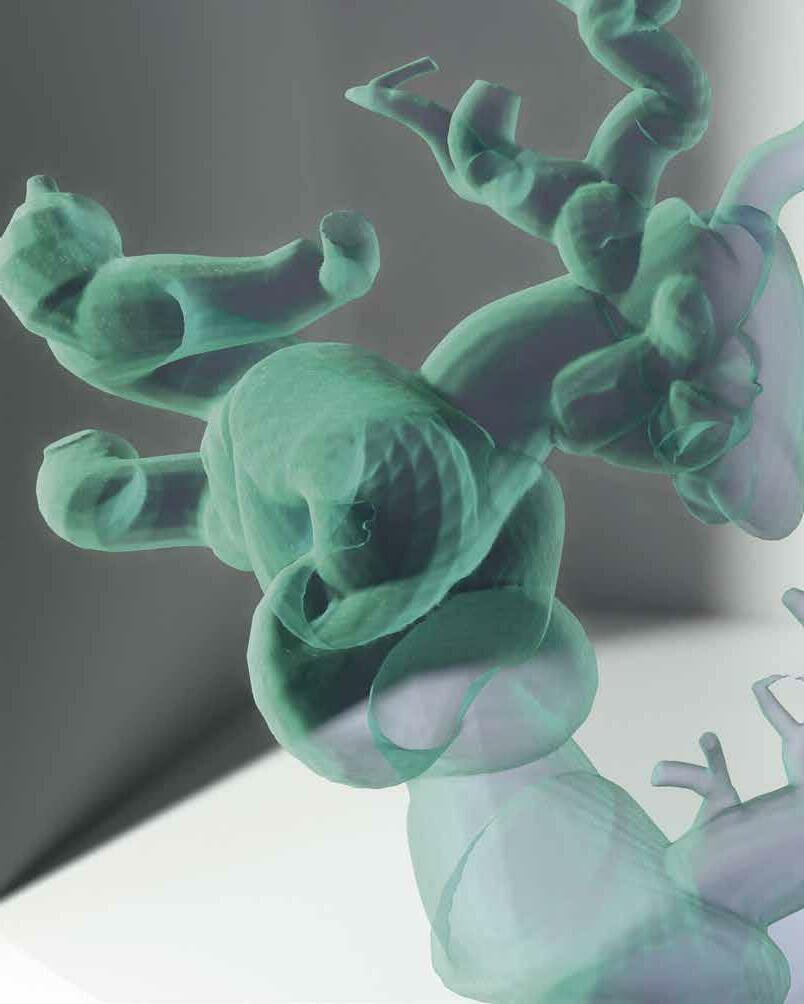
122 AR+D
Using a Tree to Represent a Tree
A tree in a diorama resisting expectations of material solidity.
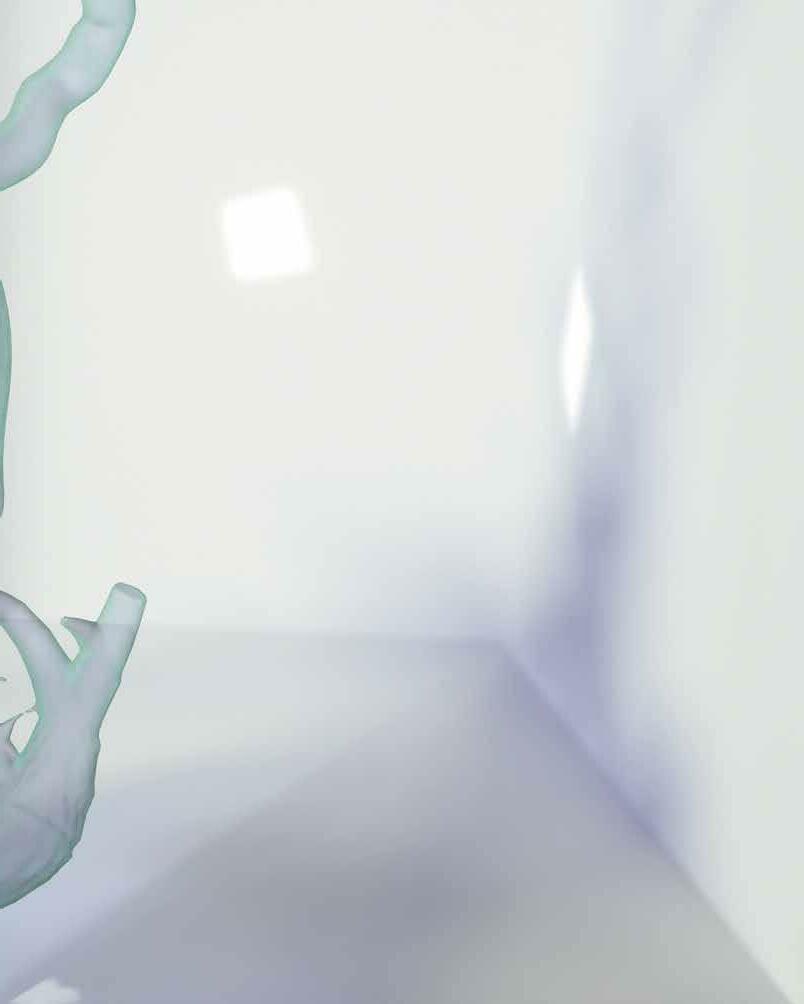
CHAPTER 3
123 AR+D
A rendering of a computational tree structure already exhibits characteristics of a natural tree.
AR+D
A digital representation of a bonsai tree is a bonsai tree. That’s a bold statement that admittedly warrants some defense. Of course, nothing digital can be considered alive, or even close to it. In a 2003 essay Sanford Kwinter writes that, “No computer on earth can match the processing power of even the most simple natural system, be it of water molecules on a warm rock, a rudimentary enzyme system, or the movement of leaves in the wind.”1 This is, for the most part, still true, almost 20 years later. To software evangelists who might take exception by noting recent developments, Kwinter is a step ahead. His position is not against computation, nor is he pessimistic about computational progress. Rather, he takes a particularly relevant position against an autonomous computational paradigm. He continues by noting the potential role for computation with respect to both material and knowledge in a way that would seem to both call for and challenge the premise of the work that follows in this chapter.
Implicit here is the idea of learning how to make matter model matter… In this use the computer becomes metallurgical substance, it extends the exploratory evolutionary process of differentiation and refinement by inventing new levels of order and shape. The computer and its software together can form a Matter/Intelligence unit of a very primitive but useful kind. But to do this, the computer, in the triad Nature-MindComputer, must play only the appropriate intermediary role of interface between Nature and Mind. This would be in clear contradistinction to what is more often the case today, where computational environments provide a customary but imperceptible experiential envelope from which Nature…is excluded and within which the activity horizon of Mind is insidiously confined. We must not believe the narcotizing hype that an emerging electronic world is poised to liberate us from a mechanical one, nor even that there exist an electronosphere fundamentally discontinuous from the mechanosphere that has formed us till now.2
Looking back on Kwinter’s warning and the contemporary post-digital break from computational exuberance, is it possible to conclude that we’ve over-corrected? Have we, as a discipline, dismissed the paradigmatic nature of digital because its everyday status perpetually reveals its limitations? Do we too regularly repress digital representations with apparently self-aware modesty? Has digital cynicism inadvertently relegated digital representation to vocational status? Perhaps taking a narrow and literal read of Kwinter’s “nature” is a way forward. Initially, it may seem obvious to note that there is no chemistry, no
125 Ch A p T e R 3
AR+D
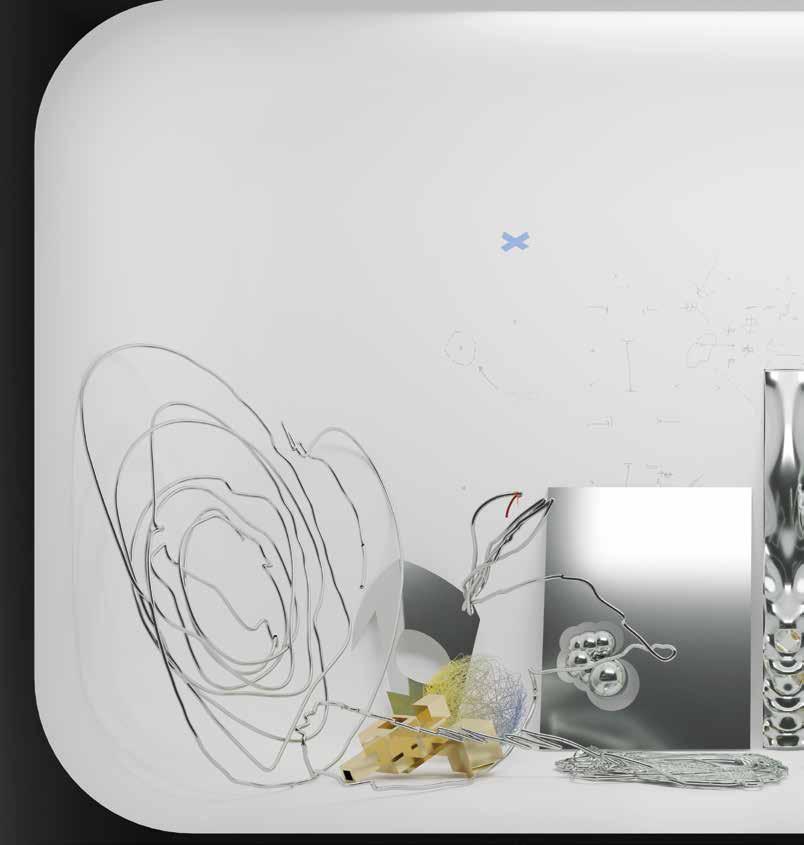
206 AR+D
A rendering of a fictional diorama in the process of being staged. Digital artifacts from tutorials and drawing machines wait to be installed.
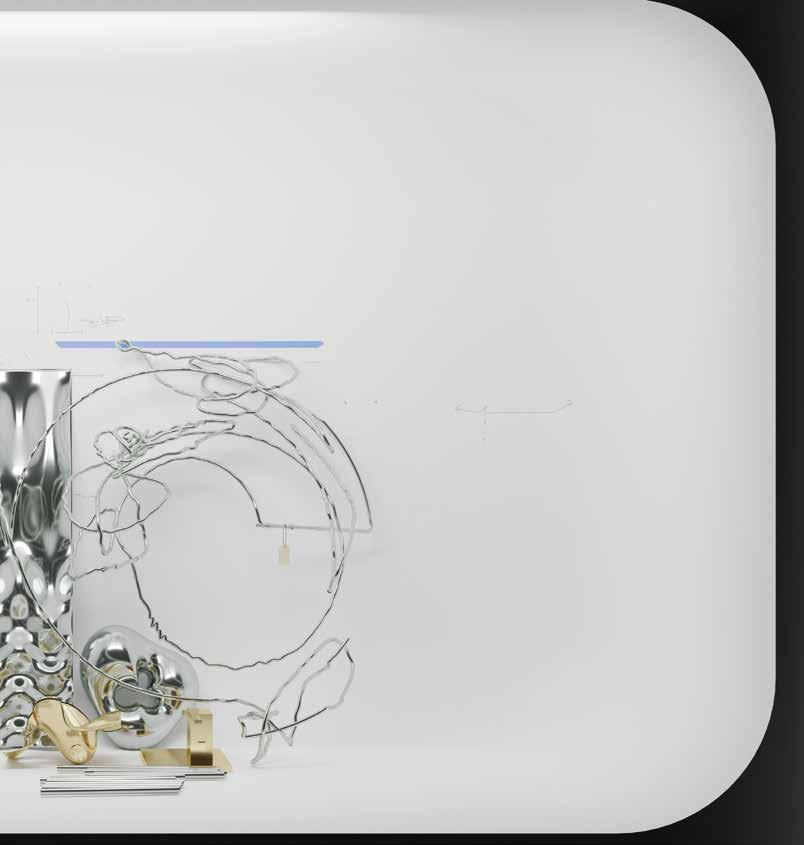
207 Ch A p T e R 4
AR+D
Surface Frictions
Extract a rendered frame from an animation of an object falling (perhaps one that has been chopped in response to an earlier exercise) toward the ground. Import that rendering as a 2-D plane (or texture map the image onto a 2-D plane) within the file used to generate the rendering. Using the same physics engine, define the plane as a cloth and allow it to drape over the object that has fallen to the ground. Now, the representation of the object is materially dependent on (and a mask over) the object itself. In preparation for a rendering from a top-down view, adjust physics parameters, transparency, and lighting in the scene. Aim for a level of visual discomfort—a violation of expectations and a representation that seems conflicted about what it is, and what it is representing. After rendering the top view, consider using that image as a texture map for another render of the original object. Align and misalign 2-D and 3-D information by paying attention to the qualities of the 3-D digital atmosphere that call out to you.
AR+D
266 EXERCISE
Lyricism and Empathy
(Or Bad Responses to External Calls)
So far, the work shown here has rendered the condition of duress that resides on the violence-aggression axis through two primary streams: first, formal and visual operations and second, the use of digital simulation technologies. The notion of the informed creative author is under pressure in this framework. We might ask, for example, how one of the animated sequences considered earlier would differ in another author’s hands? And is one’s author animation more valid than the other’s? As we extend this line of inquiry, we can helpfully turn to perceptual mechanisms guided by lyrical influences and phenomenology of empathy.
Normal perception is biased towards instrumentality rather than vibrancy, simplification rather than open-ended reception.
—Jane Bennett, Influx and Efflux: Writing Up With Walt Whitman, 2020.
In an attempt to return to moments more attuned to the sensorial and physical aspects of the human creative agent, we should first note that our current cultural (working) bodies are prone to aggression as a counterforce to structural violence. In the quote above, political philosopher Jane Bennett illustrates a human “I” whose perception has been trained in the post-industrial age to look for efficiencies, simplification, and structure. This is a violent form of training of the human I. It is a violent act indeed to enforce a rigid, top-down training of perception on an I that is human; an I that is capable of much more complex and aleatory influences. Fortunately for us, Bennett also argues that it is possible to move past “normal” perception. And in order to do so, we need to be bad at looking for efficiencies, and good at looking for atmospheric forces and invisible calls of things. An aid that Bennett suggests for overcoming the crux of normal perception is her theory of lyrical force. She postulates that when a viewing subject encounters a thing that has lyrical force, they can be overcome with extraordinary fascination. She supports this postulation further by arguing that our human perception is in fact structured to look for these extraordinary moments and describes the encounter as a moment between impression (receiving information) and expression (processing received information).
In her book, Bennett makes a case for people who she considers to be more attuned to the material world—hoarders. Though hoarding is considered a
267 Ch A p T e R 6
AR+D
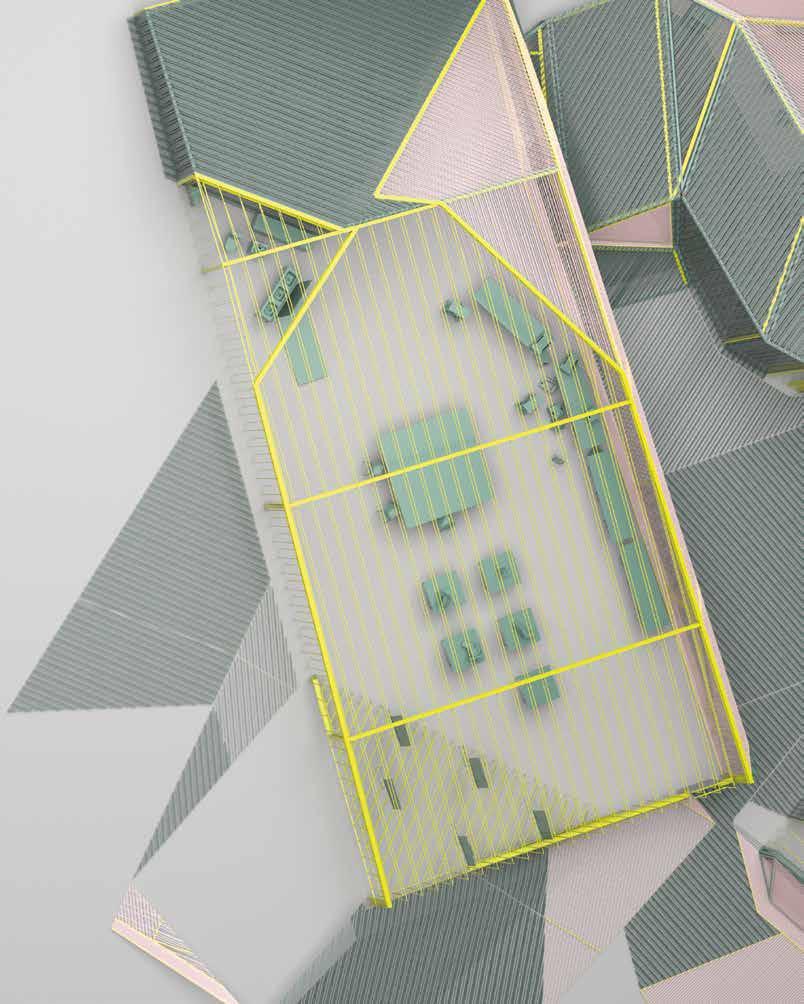
AR+D
This drawing, part of House 2, is a design research exercise that results from the conflation of 2-D and 3-D information. The house proposal attempts to discover lineages between architectural elements and digital design operations.
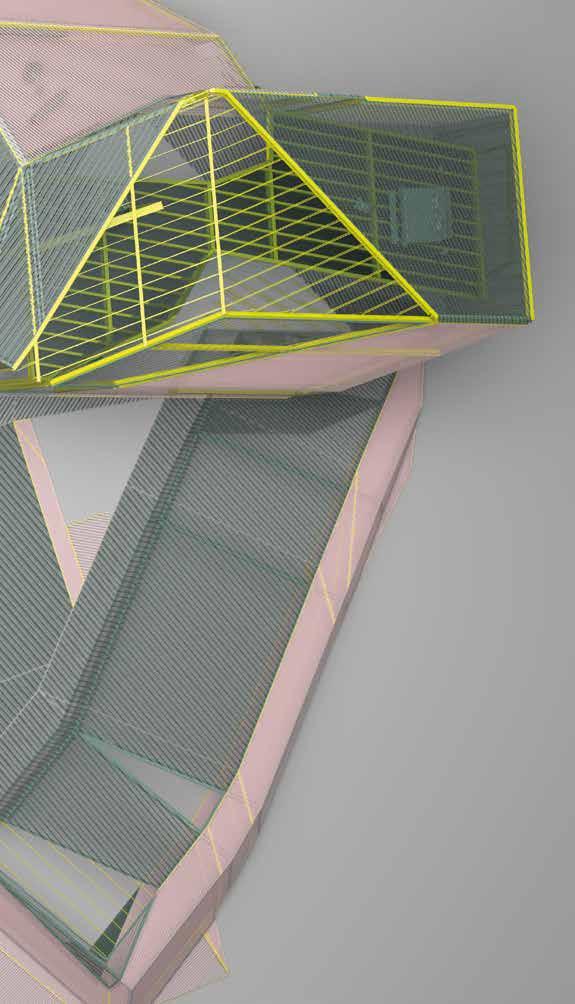
AR+D
Displacement of the Viewing Subject
One feels a palpable sensibility emerging in the use of gaming engines in fine art and experimental architecture. This manifests in attempts to give visual form to capitalist junk space and ominous, animate material worlds. Though many examples are extraordinary in their visual scope, experimentation, technical acumen, and ability to render elusive cultural conditions and ideological positions, the visual trends of this work tend to gravitate towards open worlds, ruined landscapes, and non-descript cityscapes littered with the detritus of digital libraries/warehouses, exemplified in the work of artists like Jon Rafman and Cao Fei. Architecture and physics that might inform actual tectonic assemblies in these works are largely, and purposefully, left out of the equation. Graham Harman’s mythic tale of a massive Ferris Wheel that acts as a kind of Noah’s Arc for an infinite catalog of objects (“thousands of beings” including animals, bombs, power generators, prisoners, loudspeakers, active explosives, etc.) could be a literary-philosophical corollary to this genre of work.23 Here again it’s helpful to cite Brendan Keoh’s writing on our sensory experience of video games. Keoh insists that gamer-phenomenology is one that marries human perception, the physical apparatus of the machine’s hardware, as well as the virtual (immaterial) space the user inhabits. One could also cite Military theorist Antoine Bousquet’s technical analysis of perspective as a device that weds subjective experience and objective space by way of sensing, mapping, and imaging. To adopt gaming tools and to study game worlds is not to displace the human subject in favor of an object’s-eye-view.
Framing the perspective view in video games as an essential element of contemporary architectural representation generates profound implications for form-making and the construction of space. Just as the promenade, windshield-camera view, and scenographic perspective created reciprocal conversations between form creation and perception, the evolution of the gamer’s view motivates the art of level architecture. As with the other elements explored in this book, this attention to the representational element brings it closer to reality, not farther from reality. While video games might offer a commentary on existing reality, they also constitute realities.
While hobbyist level design (“modding” existing games with accessible engines) has been a subculture of gaming since its inception, and game design is now an autonomous, specialist profession, newly available gaming engines are making level design more accessible to architects and designers with little or no engineering background. The architecture of level design and the companion art
322
AR+D
of worldbuilding constitute a new representational paradigm that is becoming commonplace in architecture studios. As such, our discourse needs to expand to accommodate the specificities of the geometric environment in games and conversely, allow those experiments to inform our built work. With the ascendance of gaming culture, millions of users inhabit virtual spaces on a daily basis and are as familiar with the anonymous corporate, industrial, military, urban, and futuristic complexes of games as they are with their own neighborhoods and places of work, recreation, and leisure. That the architecture of such environments follows a pattern language that one can clearly track to the inception of 3-D gaming, merits analysis, and design experimentation. Perhaps most notable for architecture in this language is the devaluation of sculptural form, in favor of networks designed almost exclusively for a mobile, goal-oriented, perspective view. The ubiquity of certain elements in this grammar such as the complex, linear infrastructural spines, networked objects, and other spatial archetypes like the labyrinth, arena, and tower privileges objects-ina-field or architecture-as-open-network. In this, gaming spaces are affective arenas; participatory spaces designed as datums for movement, social interaction, exploration, self expression, and play.
323 Ch A p T e R 7
AR+D
AR+D
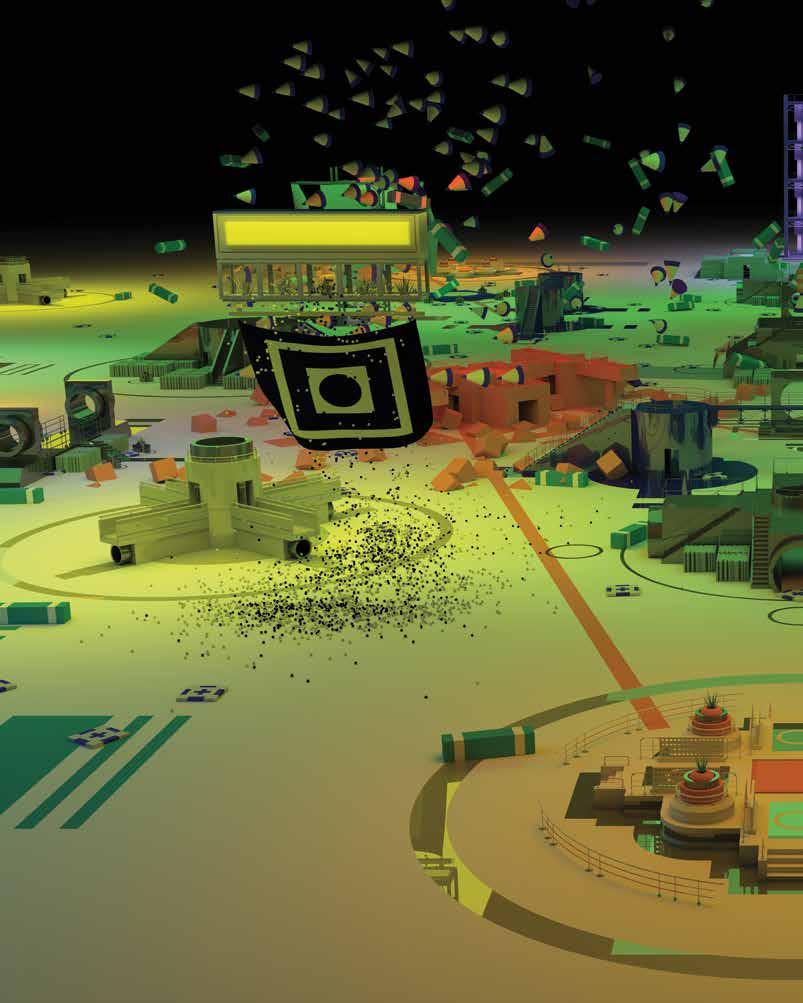
AR+D

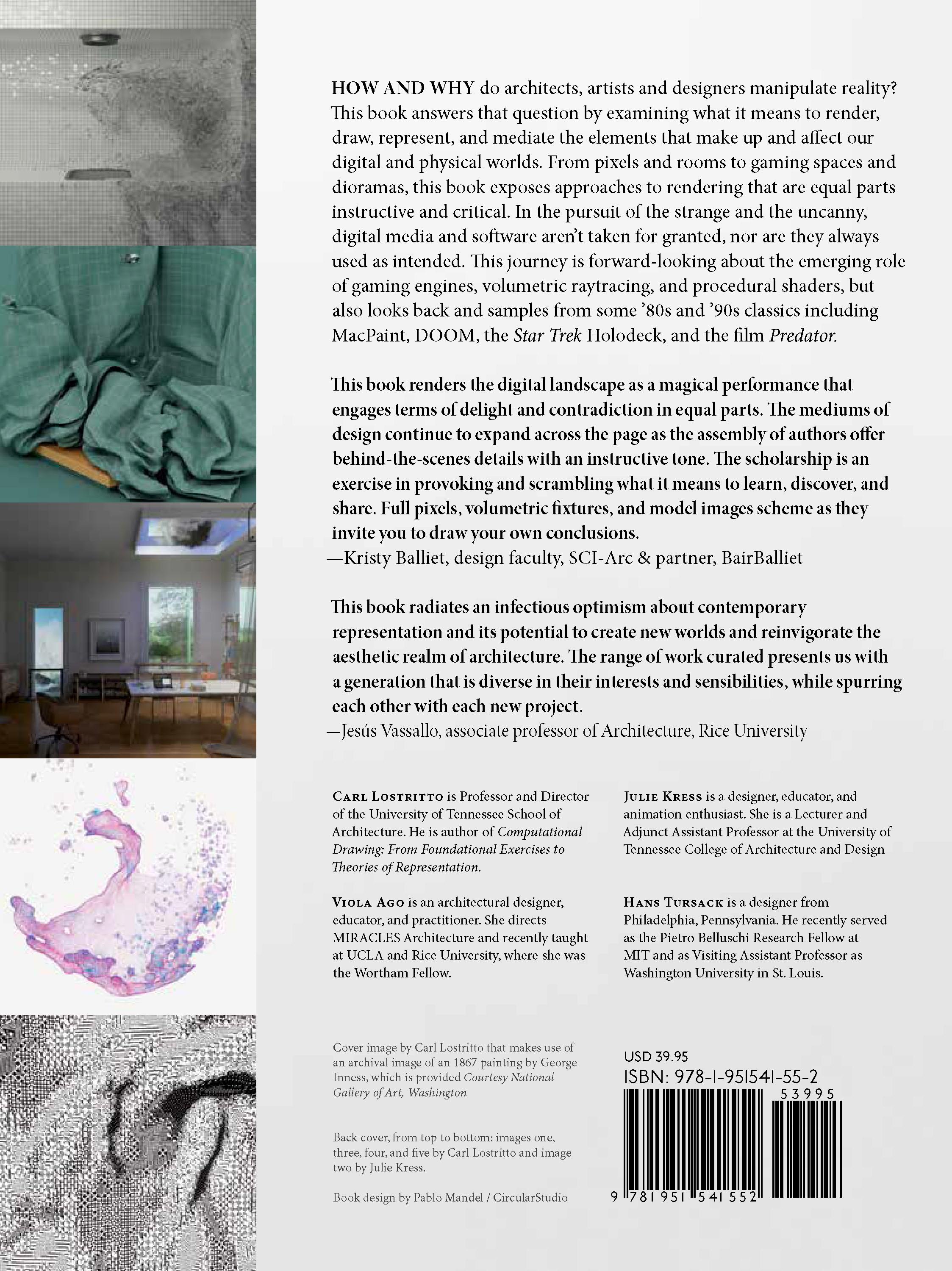
AR+D












